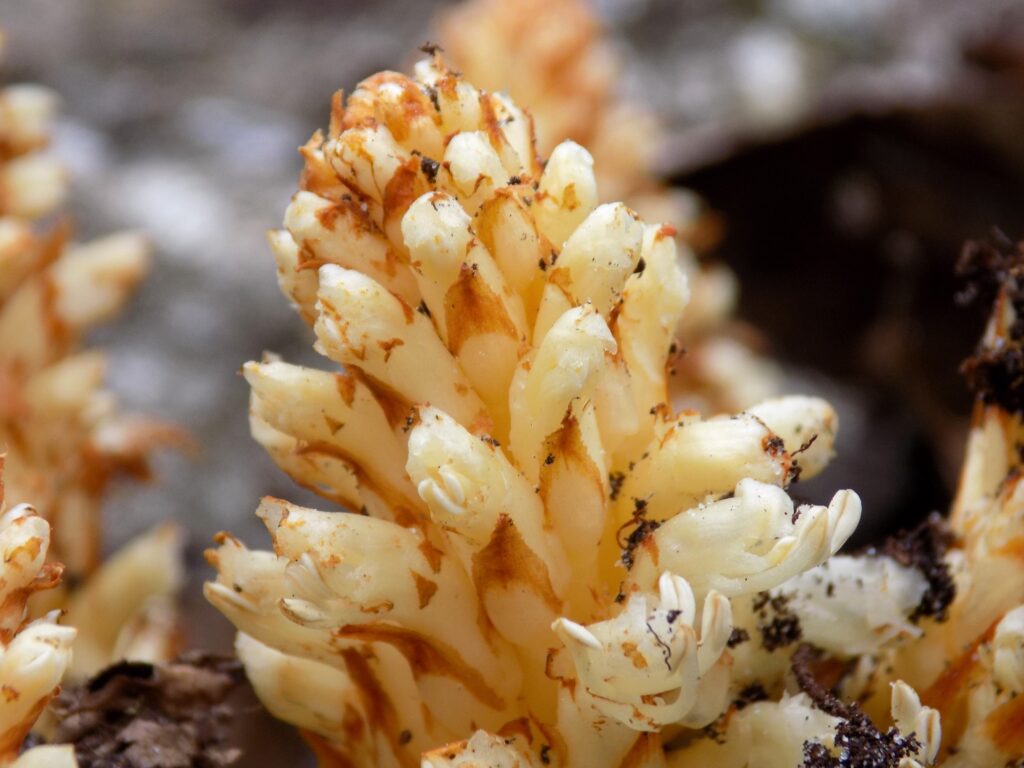
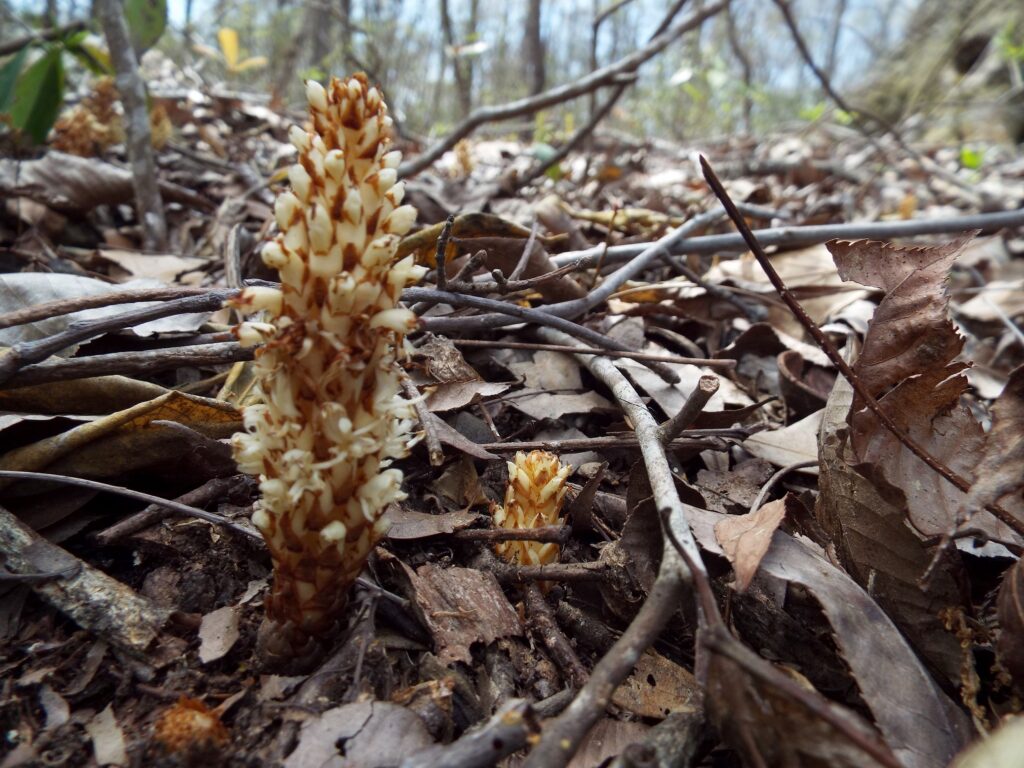
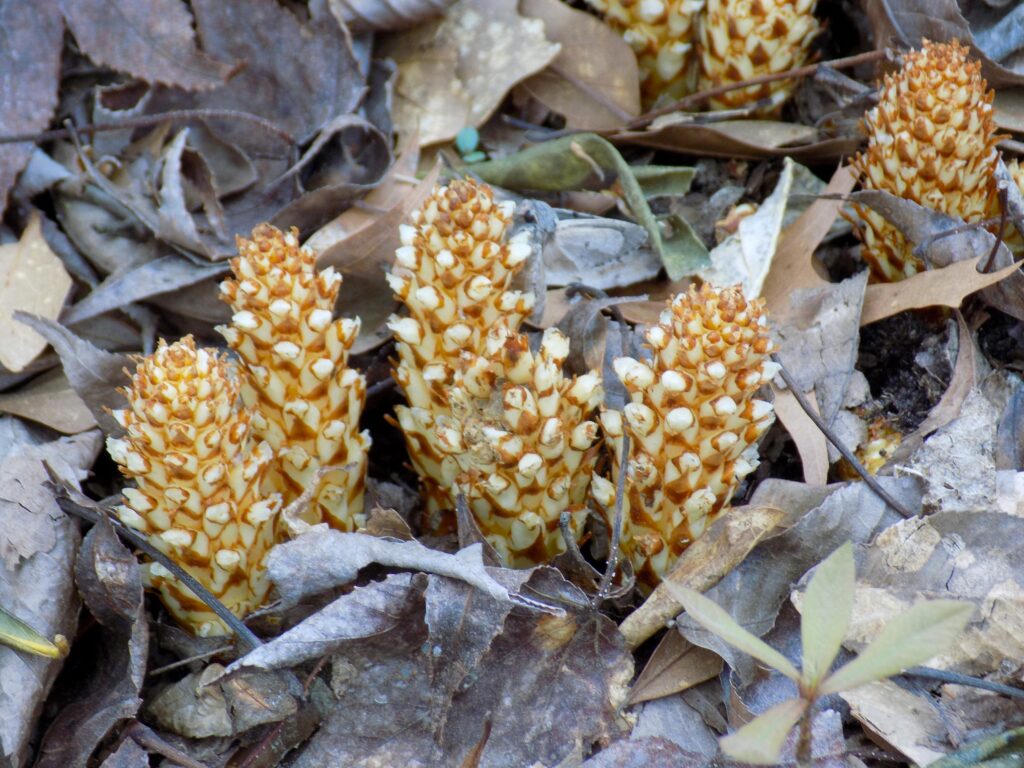
This week for Flora and Fauna Friday it’s another subterranean parasitic plant, Bearcorn (Conopholis americana).
Bearcorn, AKA Squawroot or American Cancer-Root, is a non-photosynthetic, parasitic, subterranean angiosperm. Much like Indian Pipe, which I’ve written about before, it lives its life entirely underground and is only visible when it blooms. However, unlike Indian Pipe, Bearcorn blooms in spring rather than fall and it belongs to a different family of plants, Orobanchaceae. This family of plants is well known for their ability to parasitize the roots of other plants, Bearcorn being no exception. Bearcorn is holoparasitic, meaning it survives entirely from parasitism and its cells contain no chlorophyll. However, unlike Indian Pipe, it parasitizes other plants directly rather than indirectly through the mycorrhizae. Bearcorn taps directly into the roots of an Oak tree, specifically one of the Red Oaks, and siphons off both calories and nutrition while forming a root gall underground. In early spring, Bearcorn blooms with a cluster of flower spikes, thick and creamy-yellow in color. These flower stalks are short and cone-shaped. Their resemblance to tiny corn cobs and palatability to wildlife earned them that common name of “bear corn”. The flower stalks can persist for several months and eventually wither into a dry brush-like shape. This makes it easier to detect for several months after but the flower’s full display is only short-lived.
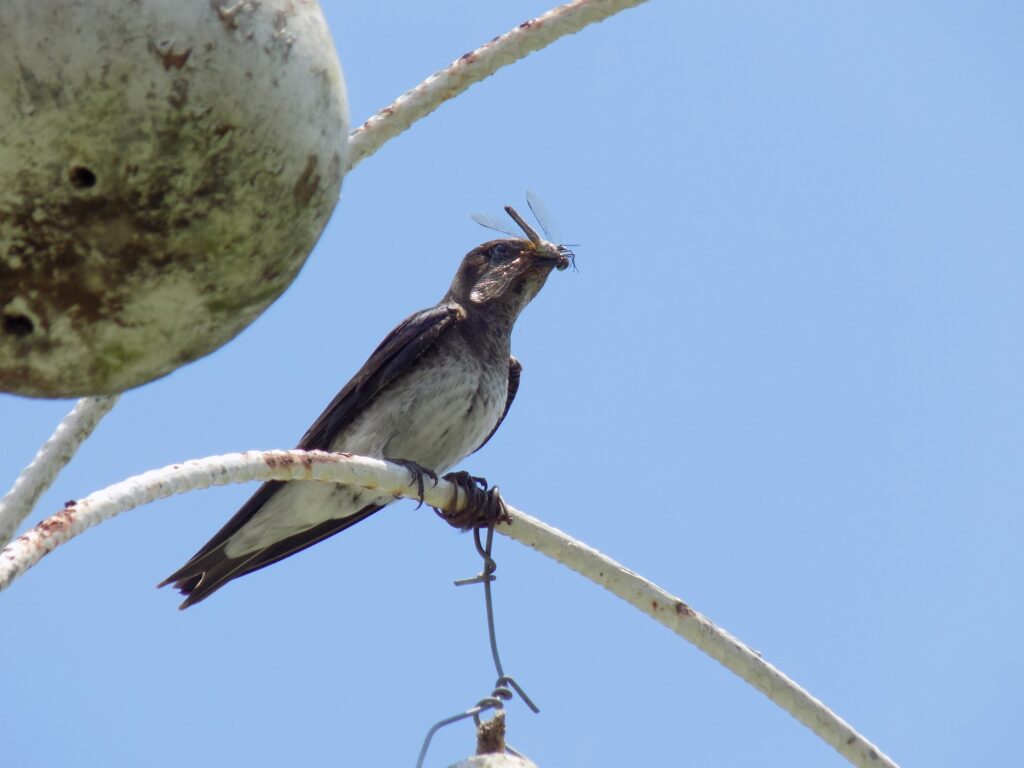
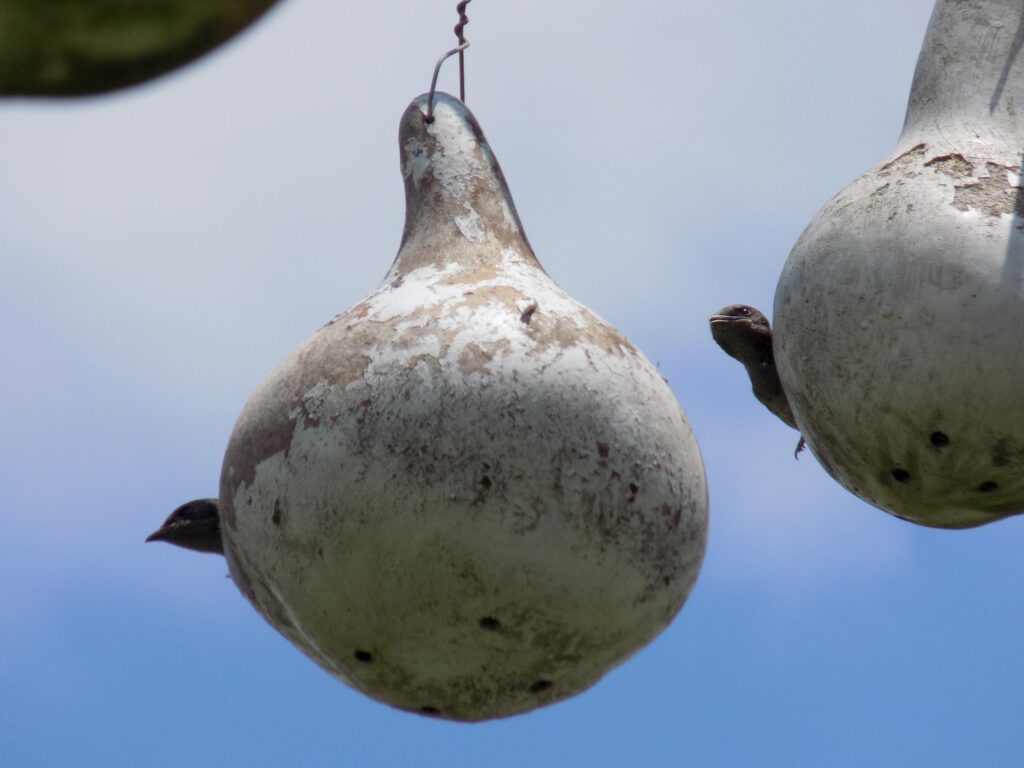
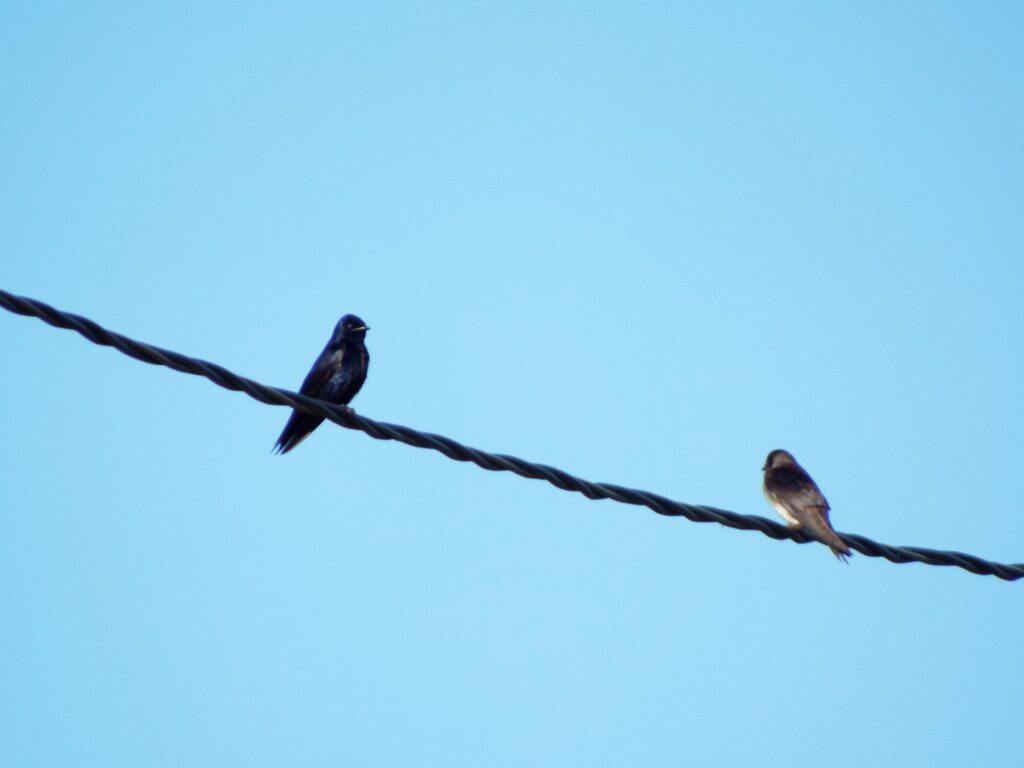
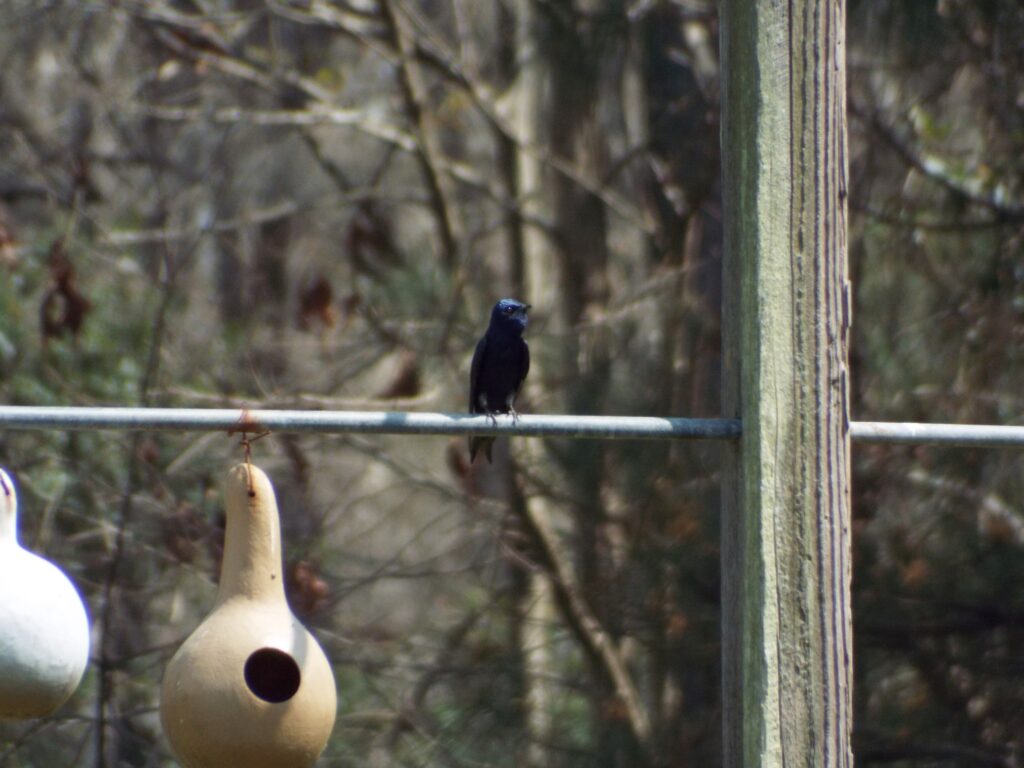
This week for Flora and Fauna Friday we have the high-flying harbinger of spring, the Purple Martin (Progne subis).
The Purple Martin is found throughout the Eastern United States and is our largest species of Swallow. Like all our Swallows, they feature long, pointed wings, a streamlined body, a small beak, and short, delicate legs. However, unlike our other Swallows, they’re of a stockier build and darker complexion. Purple Martins get their name from the plumage of the male who is drenched from beak to rump in metallic indigo feathers and fringed by semi-gloss black flight feathers. Females are not as striking, with their beige bellies beneath dusky gray backs, but still stand out on the wing. Purple Martins are a fair bit larger and usually a shade or many more darker than our other Swallow species, making them easy to identify in the air. Even so, you’re more than likely to hear them before you see them. Their sky-high chaotic song composed of bubbling electronic samples is hard to mistake for anyone else. Purple Martins are insectivores. They eat insects of all shapes and sizes and catch all their food on the wing. Martins snag their to-go orders by skillfully employing their impressive speed and agility. Swallows are some of the fastest and most maneuverable bird species there are and their large, broad mouths help funnel in prey. They even drink while flying by skimming the surface of the water.
Other than the purplish plumage, the big thing that sets Purple Martins apart is their proclivity for colony nesting. A few Purple Martins begin arriving in the Lowcountry from their wintering grounds in South America in about mid-February. These early birds, nicknamed scouts, are older adults returning to their prior haunts. Over the coming weeks, the remaining birds trickle in in increasing numbers and begin to establish that year’s breeding colonies. These colonies can be anywhere from a handful of birds in a single house to several hundred across a property. It really just depends on housing if the habitat is good. Martins can be defensive and are known for dive bombing people or predators who get too close for comfort. Purple Martins now nest almost entirely in artificial nestboxes in the Eastern United States. Originally, Martins were cavity nesters that used old Woodpecker nests. Yet, they’ve now urbanized to preferentially inhabit avian apartment complexes of hollow bottle gourds and claustrophobic condominiums. Interestingly, this shift occurred only in the last few hundred years and has become a permanent fixture of their ecology. Native Americans erected Martin-houses using bottle gourds prior to the arrival of European colonists. Their reasons for doing so aren’t understood but the Martins took kindly to the gesture nonetheless. Later, colonists emulated the Native American practice and apparently appreciated the beautiful bubbly birds as well. Before long, much of the Martin’s natural nesting habitat had been destroyed by logging and the birds became dependent on artificial nests. Nowadays, not only do they nest entirely in nestboxes but, when given the option, Martins actually prefer nesting near human activity rather away from it. If you’re interested in making friends with Martins, consider erecting a Martin house for next year. They love open fields, ponds, and singing to their ground-dwelling neighbors.
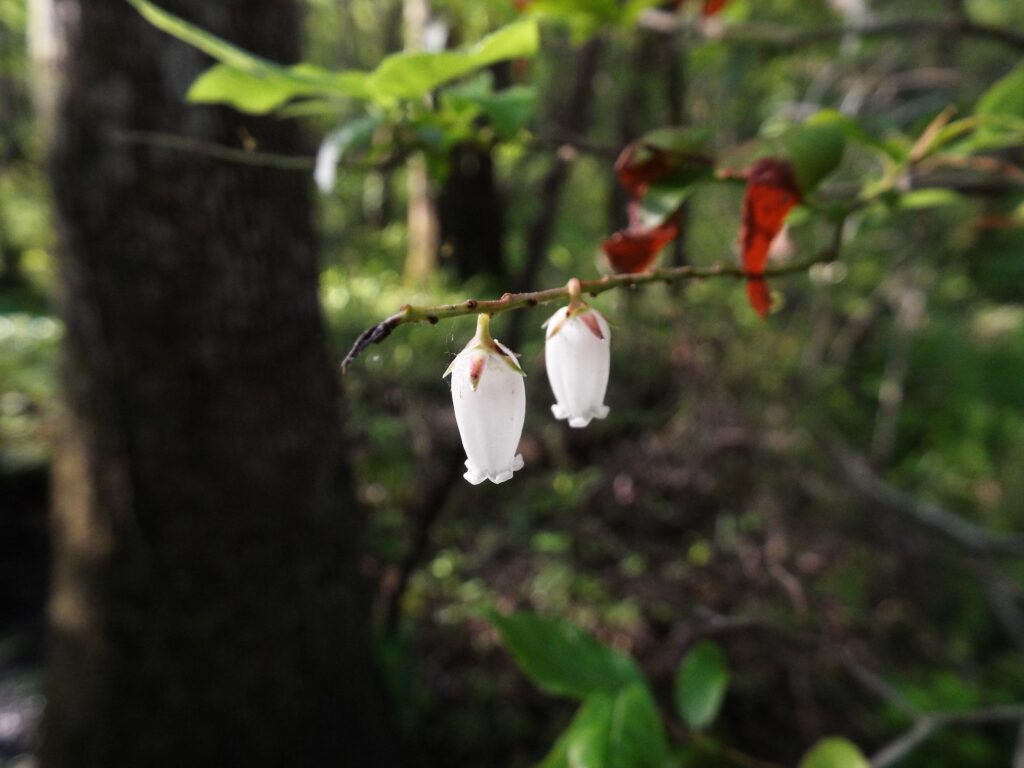
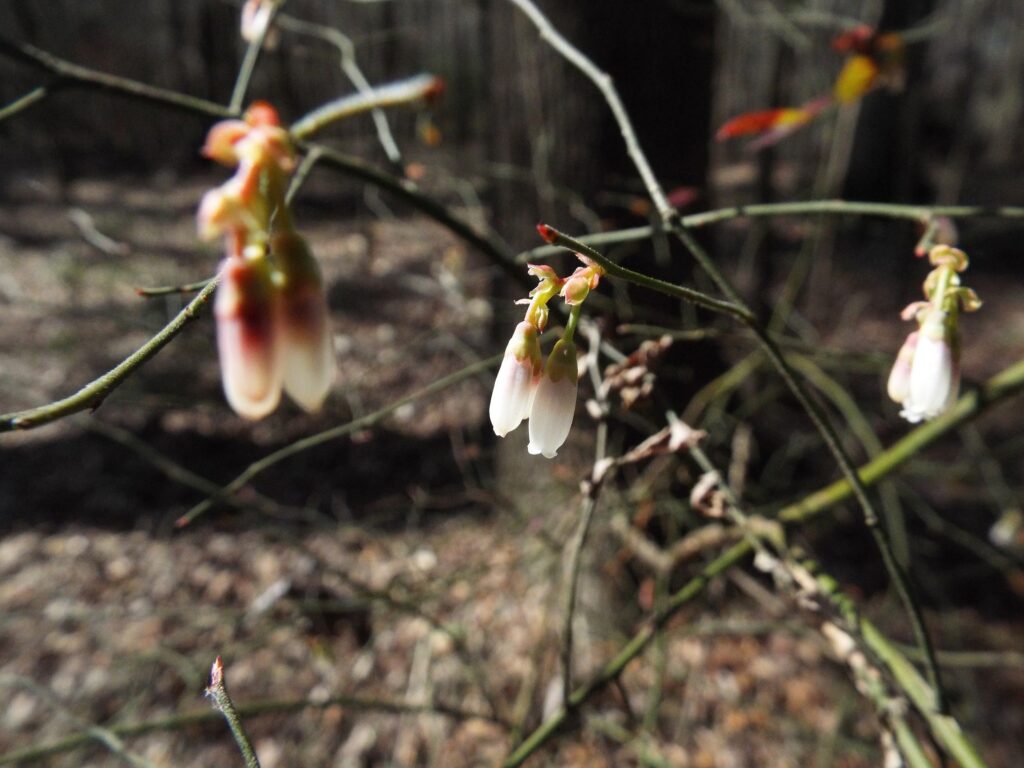
This week for Flora and Fauna Friday we have a widespread spreading shrub that’s all the rage this time of year, Blueberries, genus Vaccinium.
Blueberries are a diverse genus of bushes native to the Southeast. The genus of Vaccinium includes not just Blueberries but also Cranberries and Huckleberries as well as the locally native Sparkleberry bush. Here in the Lowcountry, we have about eight species that can be considered proper Blueberries, at least one Huckleberry, and the aforementioned Sparkleberry. The Blueberry genus belongs to the Heath family, Ericaceae, which includes many of our most popular southern shrubs, such as Azaleas, Rhododendrons, Mountain Laurel, and Fetterbush. Heaths as a whole are gnarled growing, laterally spreading, acid soil loving bushes with spring flowers and a thicket forming nature. Blueberries tick all of those boxes but are not as extreme as many of their relatives.
Blueberries grow in forested habitats on a wide array of acidic soils all across South Carolina. Spreading from fire scorched savannas, up ravenous hillsides, over barren sandhills, and into stagnant Carolina Bays you can rarely go far in our state before running into a Blueberry of some shape or form. Blueberries can differ a great deal in appearance between the different species. Some species form low, expansive thickets only a foot or two above the soil while others crawl along the ground like a vine and yet more climb ten-foot high above the forest floor. However, all share similar traits in their leaves, their stems, their flowers, and, of course, their fruits, which distinguish them as Blueberries. All our Blueberries have small, simple leaves with a slightly leathery texture and of a paler hue of green erring on the yellow side of the spectrum. Some species are evergreen, some deciduous, and some can’t make up their mind. On top of that, they have green stems that can turn orange or red on one side when exposed to light. Regardless, their wiry, twisted growth and loose thicket arrangement are usually enough to discern their lineage while wandering the woods. Another more telling character is in their flowers: small porcelain-white urns, blushed with pink and overturned to spill their scent upon the twilight of winter. Of course, following the flowers is their namesake blue berries. The size, quality, color, timing, and flavor of our Blueberries runs the gambit between species. Some are small, dark, late, and tasteless. Others big, blue, early, and sweet. Just a handful are small, blue, late, and rich in a deep flavor that can only be ascribed as “Blueberry”. All are round and either a powdery blue or deep bluish-black in color. For the record, practically all of our cultivated Blueberries here in South Carolina belong to one of two species: Southern Highbush Blueberry (V. formosum) and Northern Highbush Blueberry (V. corymbosum). Both species are very similar, forming tall bushes that produce plentiful large fruits. They’re so similar in appearance that they used to be considered the same species. The two are both native to our area but Southern Highbush Blueberry is the more common wild plant here in the Lowcountry.
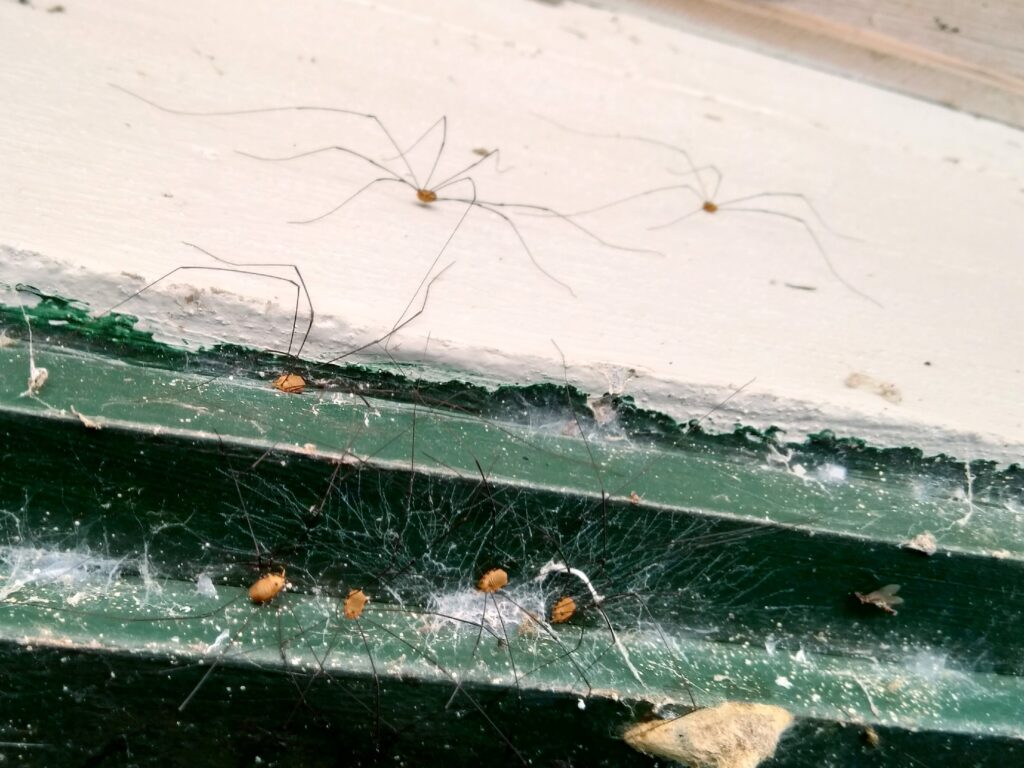
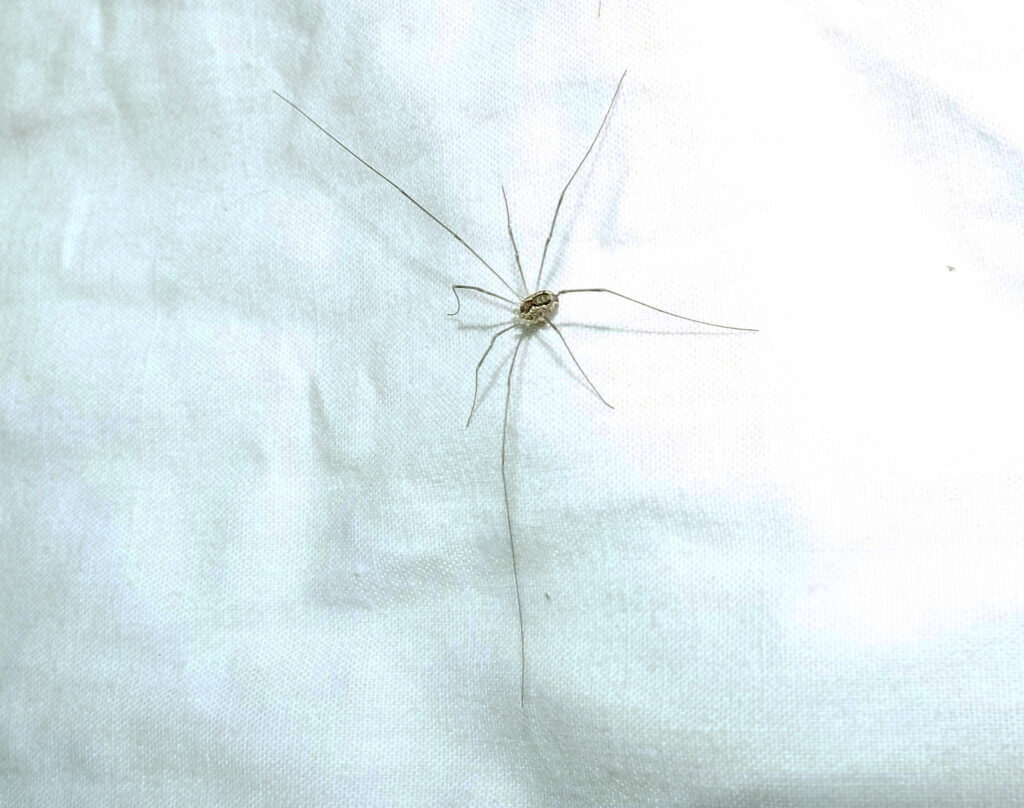
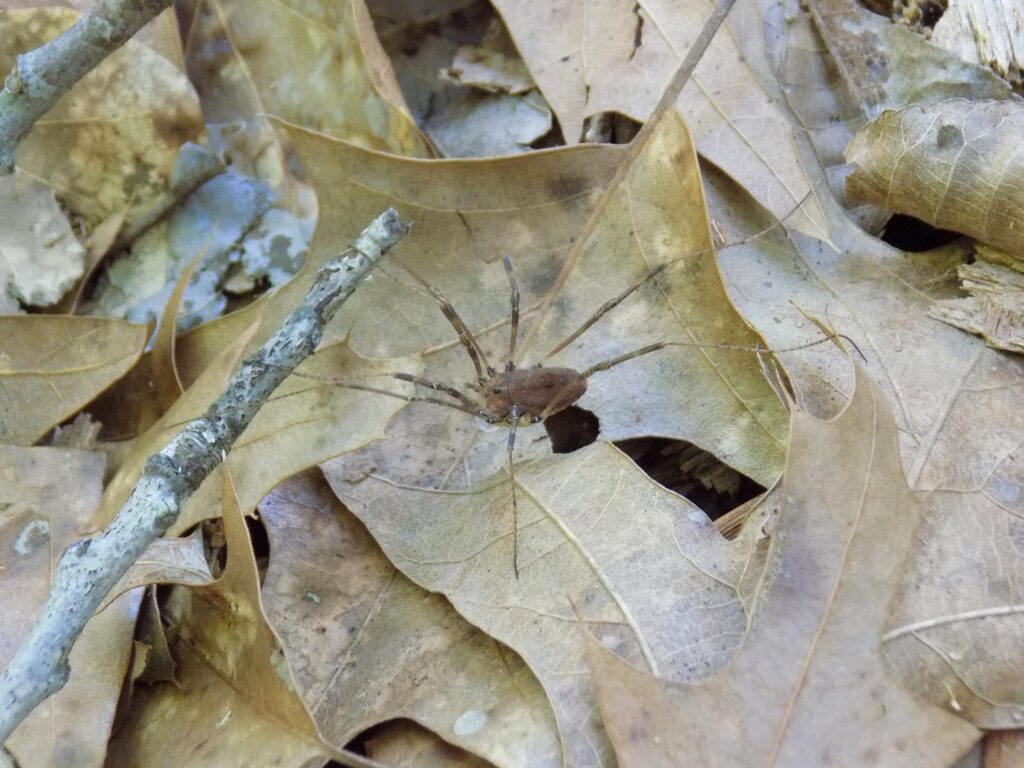
This week for Flora and Fauna Friday we have a spindly spidery critter with a superstitious reputation, the Harvestmen of order Opiliones.
Harvestmen are arthropods with quite the folklore surrounding them. I can recall quite a few childhood tales about them. Chief in my memory is how they’re supposed to be the deadliest spider around, save that their fangs are too small to puncture your skin. In contrast to this playground lore of yore, I’m here today to tell you the truths about this interesting arachnid.
Harvestmen belong to the order Opiliones within the Arachnida class. They share no close relation with spiders and are actually most closely related to Scorpions. They’re common throughout our forests and woodlands and often found huddled together in shady crooks of porches and barns. Although they come in many shapes and sizes, their general appearance is distinct and unmistakable. I won’t even pretend that I comprehend their diverse phylogeny but I believe the genus Leiobunum is the clade most of us will recall when imagining the Harvestmen of the Lowcountry; a round pale-brown body composed of a single segment supported in midair on eight articulated wispy legs. Each barely bristle-thick appendage arcing upward from the fringes of that egg-shaped center. Peering ever closer we can see a tiny cluster of beady little eyes front and center, on what passes for a head, and a pair of tiny pincers for a mouth.
Harvestmen move with either a jittering, bouncy gate or a slow purposeful walk, elongated middle limbs out stretched ahead as they feel their way forward. They have a wide and varied diet that differs between species. Most are omnivorous, some are predatory, and others scavengers. They eat their food, alive or dead, animal or vegetable, by picking it apart with their tiny pincer-like mouthparts. Harvestmen are wholly nonvenomous by the way and completely harmless to humans. However, they will release foul smelling chemicals if handled roughly. They also employ autonomy to escape from danger, shedding their wiry legs if they become ensnared. This is a costly move as Harvestmen cannot regrow their limbs and is why you’ll often find them down a leg or two.
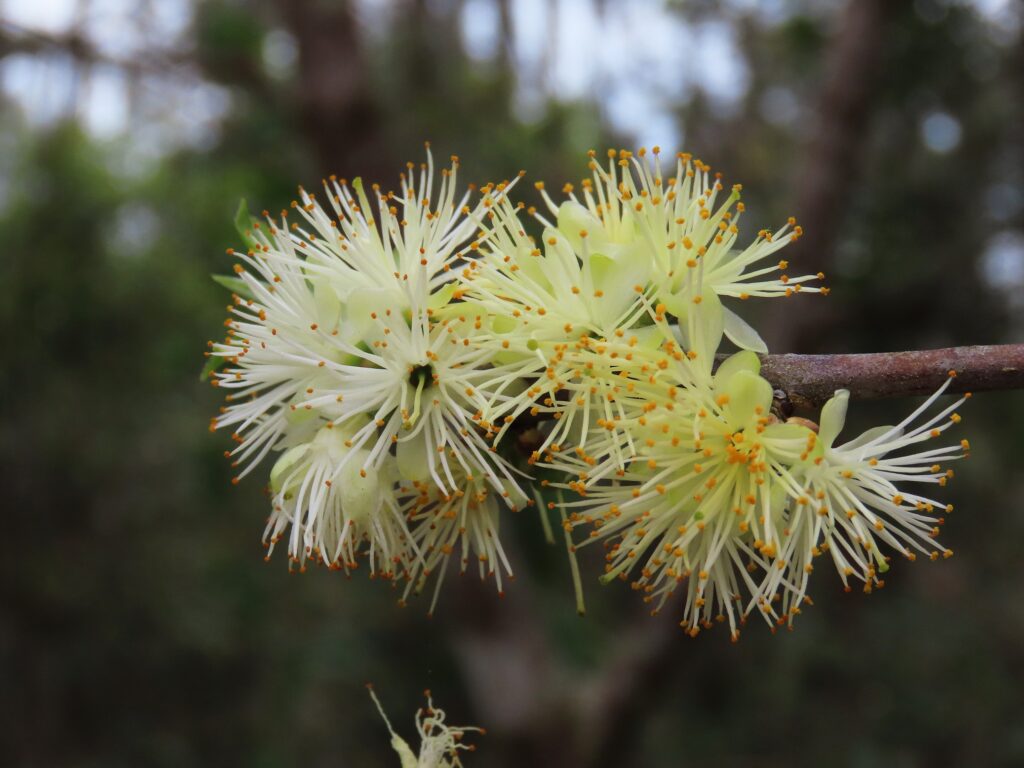
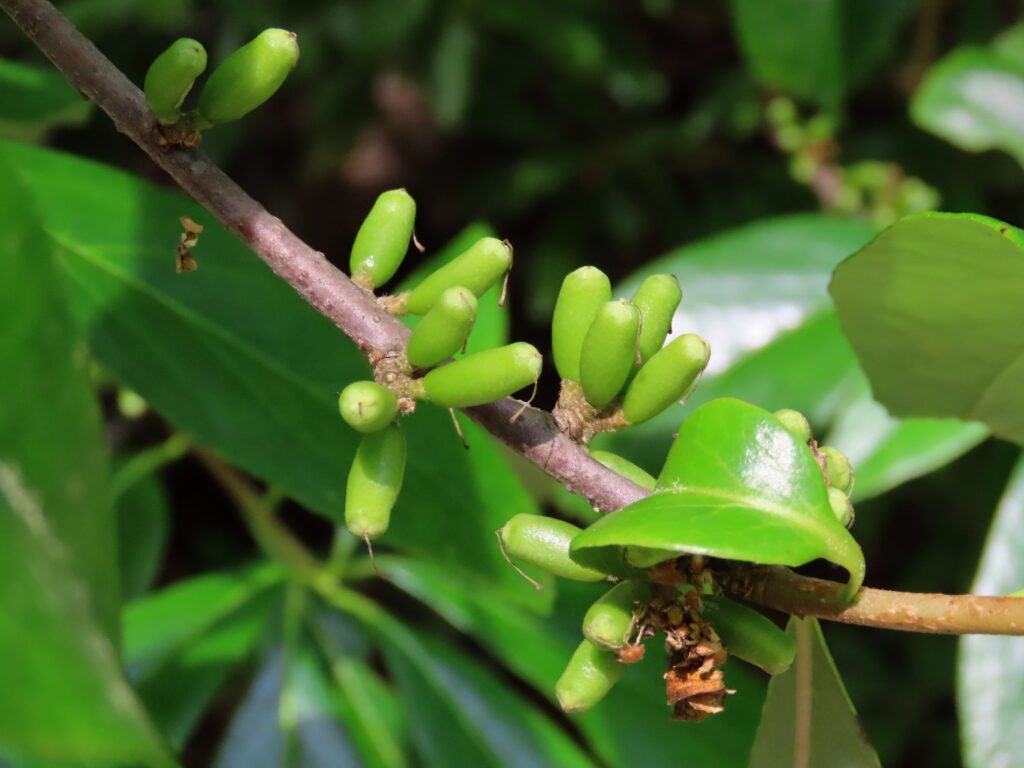
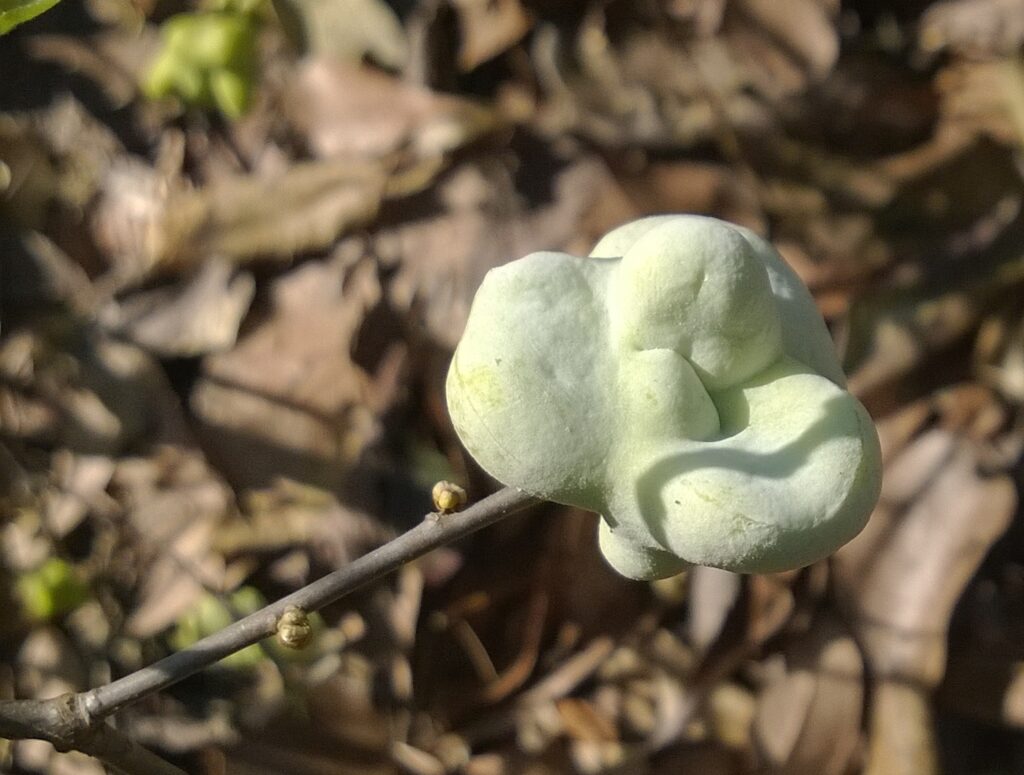
This week for Flora and Fauna Friday we have an almost evergreen understory addition to our upland woodlands, Sweetleaf (Symplocos tinctoria).
Sweetleaf, also called Horsesugar, is a large broadleaf shrub native to the Southeastern United States. Sweetleaf is an important addition to our forest ecosystems here on Edisto as it makes up a significant portion of the understory in mature upland forests around the Island. Both of its common names reference the palatability of the leaves to horses and livestock. Some say you can taste the sweetness yourself by breaking the main vein of a fresh leaf and touching it to your tongue, but I’ve never been able to taste it and Lord knows I keep trying. The specific epithet “tinctoria” means dye and the bark of the plant was once used for making a yellow dye.
Sweetleaf grows a distantly liana-like trunk sheathed in pale gray bark, mostly smooth but periodically split with furrows of cinnamon. This lumber lattice lauds large elliptic leathery leaves of emerald green, often weeping wearily when wanting water. These leaves are somewhat evergreen, as some plants will keep their leaves throughout the winter while others shed them all in fall. For as common as Sweetleaf is, its ubiquity and rather generic appearance can make it unsuspectingly difficult to identify if it’s not already on the mind. The easiest time to pick it out is in late winter. About the start of March Sweetleaf starts to bloom and its scant branches begin to glow with fuzzy flowers of cream-white and gold. Sweetleaf is one of our first flowers of the year and this final frost flush helps wake our pollinators from their winter slumber. Those flowers mature into a small, and otherwise insignificant, drupe.
Another easy way to identify Sweetleaf is by a fleshy gall that often afflicts the plant. This gall is caused by the bacterium Exobasidium symploci and it appears on Sweetleaf twigs. The gall is usually silvery blue over a lime-green base color with a rubbery, foam-like appearance. This gall is a physical mutation caused by the Exobasidium bacterium growing within the leaves or flower tissue of the shrub. These galls are generally not a health concern for the plant. However, their alien appearance in often impossible to ignore for those on an idle amble. They stand out like a sore thumb in the barren winter woods.
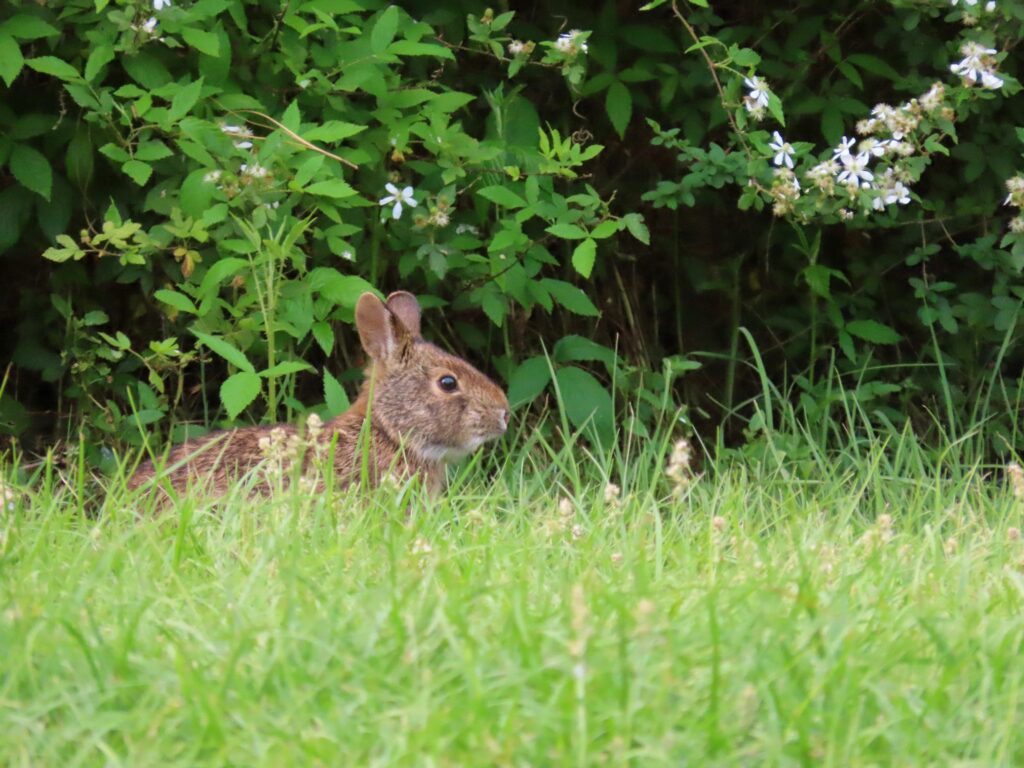
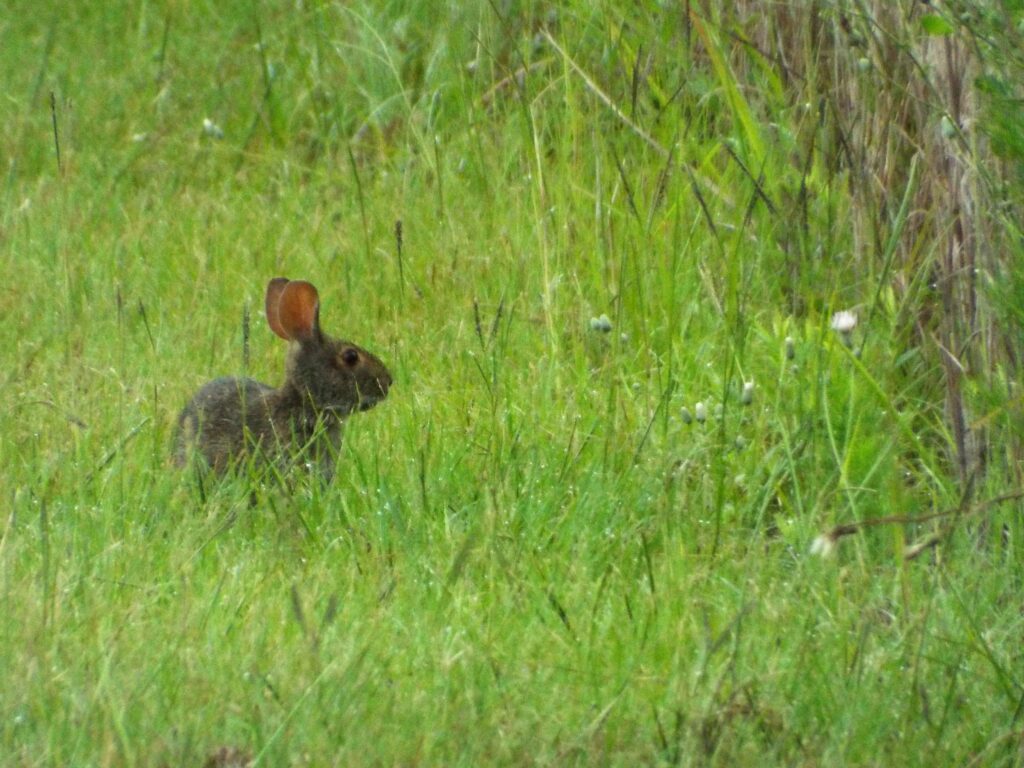
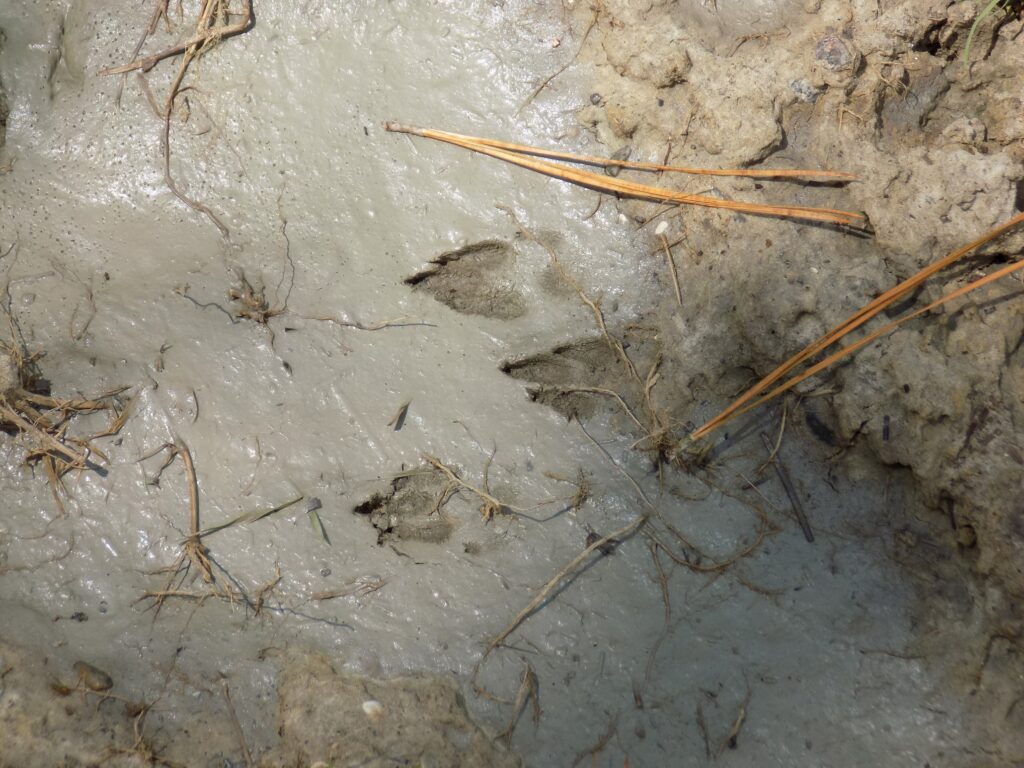
This week for Flora and Fauna Friday, we have a pair of fluffy butted, big eared, garden guests: the Cottontail Rabbits (genus Sylvilagus).
Rabbits as a whole belong to the order Lagomorpha. Lagomorphs share some superficial similarities to Rodents, as the two orders are closely related, but they’re distinct clades. One of the simpler ways to tell the two orders apart is that rodents have two incisors and rabbits have four. Here on Edisto Island we have two species of rabbit, both of which are members of the Cottontail genus. Both of our rabbits are roughly the size of a football and about the same color. They both inhabit early successional habitat, prefer to feed on fresh vegetation on the edge of open areas, and are most active at night. Rabbits are herbivorous, feeding mainly on forbs. Like White-tailed Deer, they are a prey species and, similarly to deer, rabbits have a physiology built for detection and fleeing. Rabbits have big side-facing eyes and movable cupped ears for sensing predators. These are coupled with long, muscled rear legs that allow them to accelerate rapidly to high speed in order to escape predators. This is why rabbits never tend to stray far from thickets or other dense cover.
The Eastern Cottontail (Sylvilagus floridanus) is your common rabbit found in a wide range of habitat throughout the eastern half of the United States. They’re most often found in fields, yards, roadsides, and other open habitats. They have a brindled coat of white, tan, and black fur, large beady black eyes, tall elliptical ears, and a conspicuous cottony tail. In general, they have a round shape to their head and a somewhat boney appearance. The Marsh Rabbit (Sylvilagus palustris) is found throughout the coastal plain of the southeast and is partial to marshy wetland habitats. They are quite common on the Sea Islands in maritime forests surrounding tidal marsh. Marsh rabbits have fur that is brindled primarily in browns and black, small eyes, short circular ears, and they like to keep their tail tucked away. Marsh Rabbits usually have a triangular-shaped head and a plump, guinea-pig-like appearance.
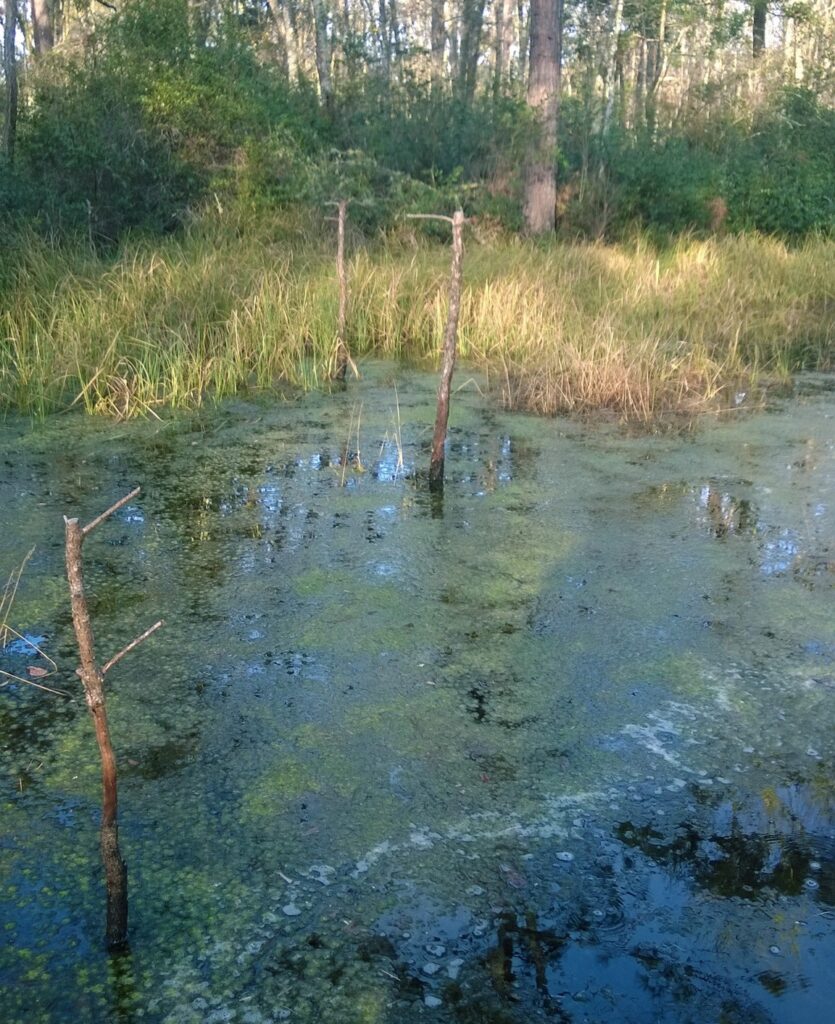
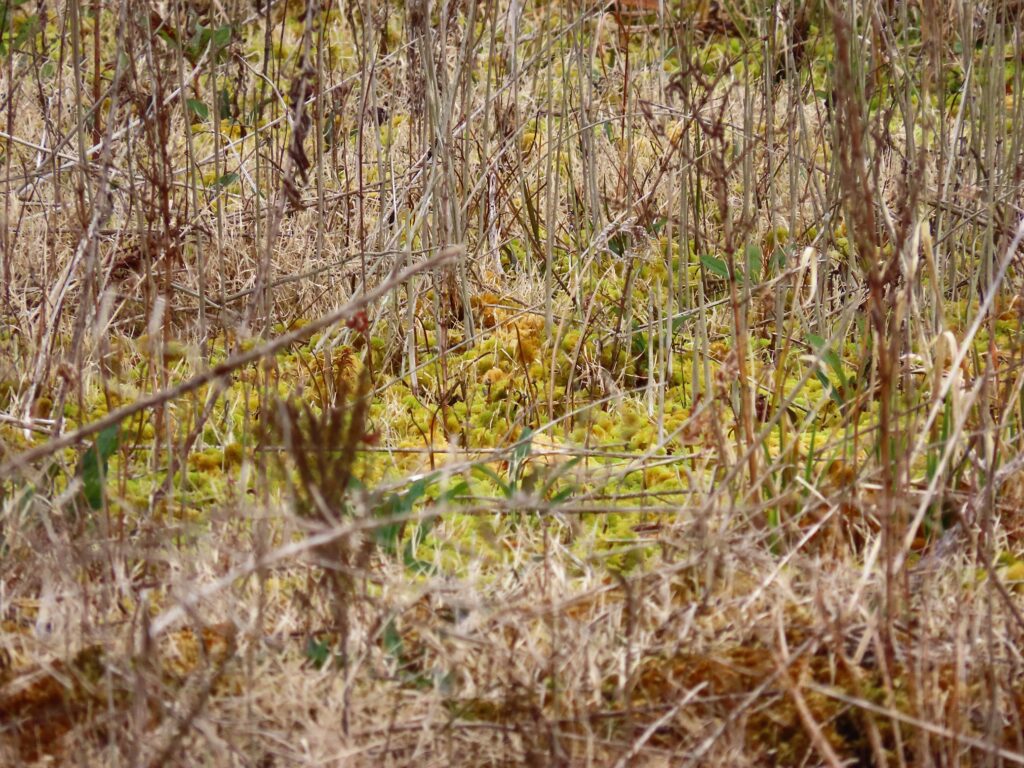
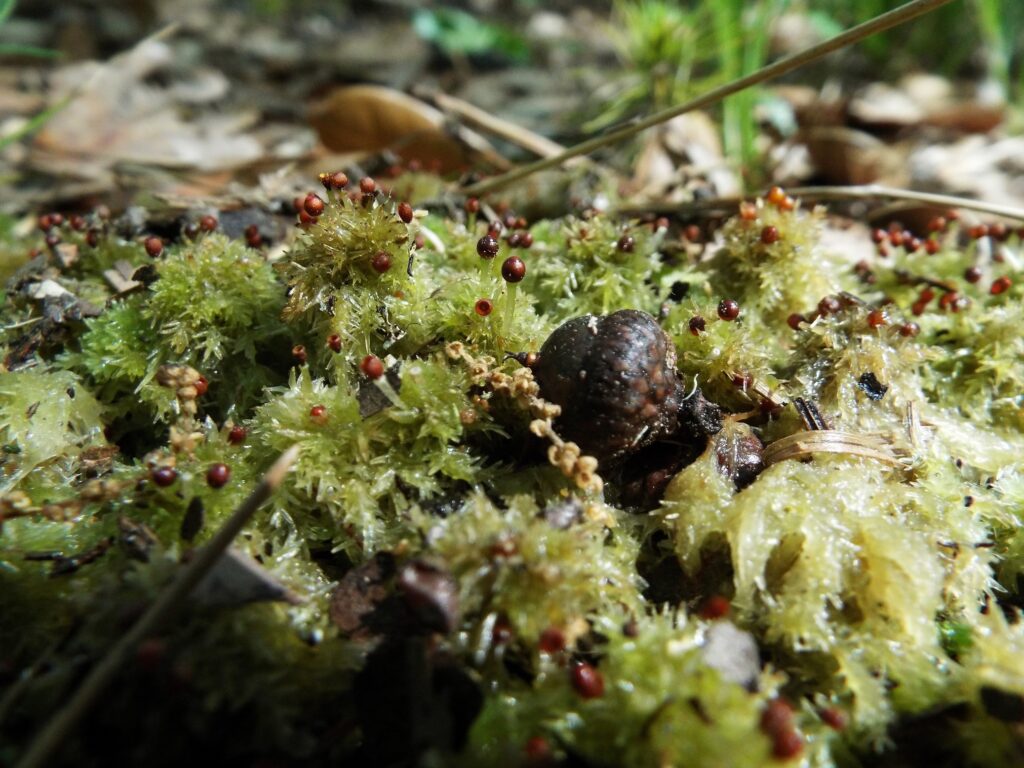
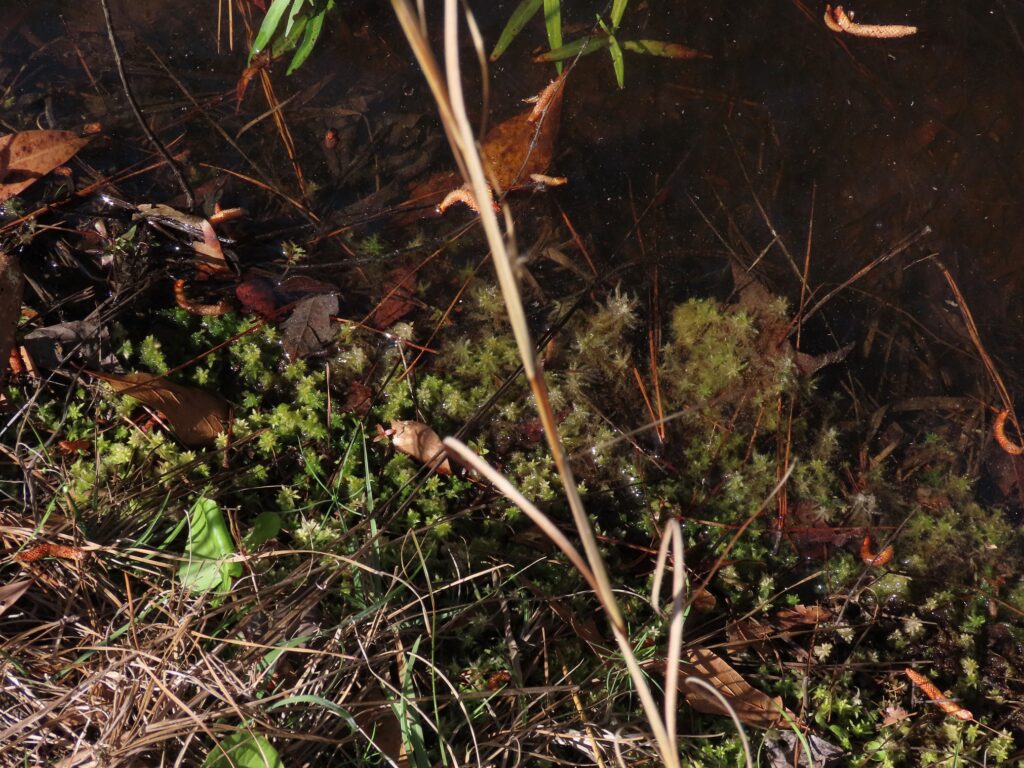
This week for Flora and Fauna Friday we have ancient acid-loving, artifact-saving, and amendment making plant to dig into, Peat Moss (Sphagnum spp.).
Peat Moss, or Sphagnum Moss, is a genus of mosses found across the globe. Edisto is no exception. These mosses love wet, acidic soils and are tolerant of drought, flooding, and extreme temperatures. So the Lowcountry sounds like a perfect home! Sphagnum does best in wet places where little else can grow. You’ll most often find them in Carolina bays, on the edges of permanent wetlands, wet depressions on highly acidic soils, ditch edges, and sometimes in the crooks of tree roots. When conditions are right, the moss can form perpetual peat bogs. Large patches of moss positioned atop deep beds of decaying peat. Peat bogs can be quite extensive and extremely deep in colder climates but tend to be much more modest in South Carolina.
Sphagnum moss comes in many shapes, sizes, and colors but all share a similar structure. It is low growing with a shaggy, lumpy form. Sphagnum is best recognized by it tufted, carpet-like appearance. Each branch of the stem is whorled in often toothed tufts of green flesh. Peat moss is different than most of the plants we’re familiar with. It belongs to the ancient group of plants called the bryophytes, to which all true mosses belong. Bryophytes are the most ancient of land plants. They are so primitive that they spread by spores and even lack vasculature structures. All water must move passively through the plant. This is why Sphagnum loves wet conditions. Yet this character is also the source of its drought tolerance. Since it can’t rely on roots or vasculature to find and pump water throughout its body, peat moss is built like a living sponge. It can store many times its weight in water in order to weather through droughts. However, it also means that it can’t grow very tall or very thick, as the further away a part of the plant is from soil moisture, the less chance it has to survive.
Throughout human history, Sphagnum has had many important uses in human society and commerce. Anaerobic peat bogs in Europe were once used for food storage, as the old, acidic, low-oxygen conditions of some bogs allowed fat rich foods like butter and lard to last almost indefinitely. In much the same manner, peat bogs can also preserve animals and organic artifacts for millennia. Some bogs have yielded stupendous findings for both ecologists and anthropologists. The accumulated dead peat within Sphagnum bogs also has many unique and useful properties. Peat can be mined and dried for several purposes. Bricks of dried peat can be burned as a commercial fuel source or stacked as a primitive insulating building material. This same peat can be shredded to create a powerful soil amendment that dramatically improves the water and nutrient holding capacity of mineral soils. Shredded peat moss, when dried, is highly absorptive and strongly acidic. These traits make it great at staunching bacteria and mold growth. These traits have not been overlooked and it has been used for centuries for moisture control when packing perishable materials, absorbent baby diapers, and even as sterile wound dressings! You may have also heard of the short-lived peat mines here in the ACE Basin. These operations mined a different kind of organic material, also called peat, which originated beneath our bottomland forests, not the kind produced by Sphagnum.
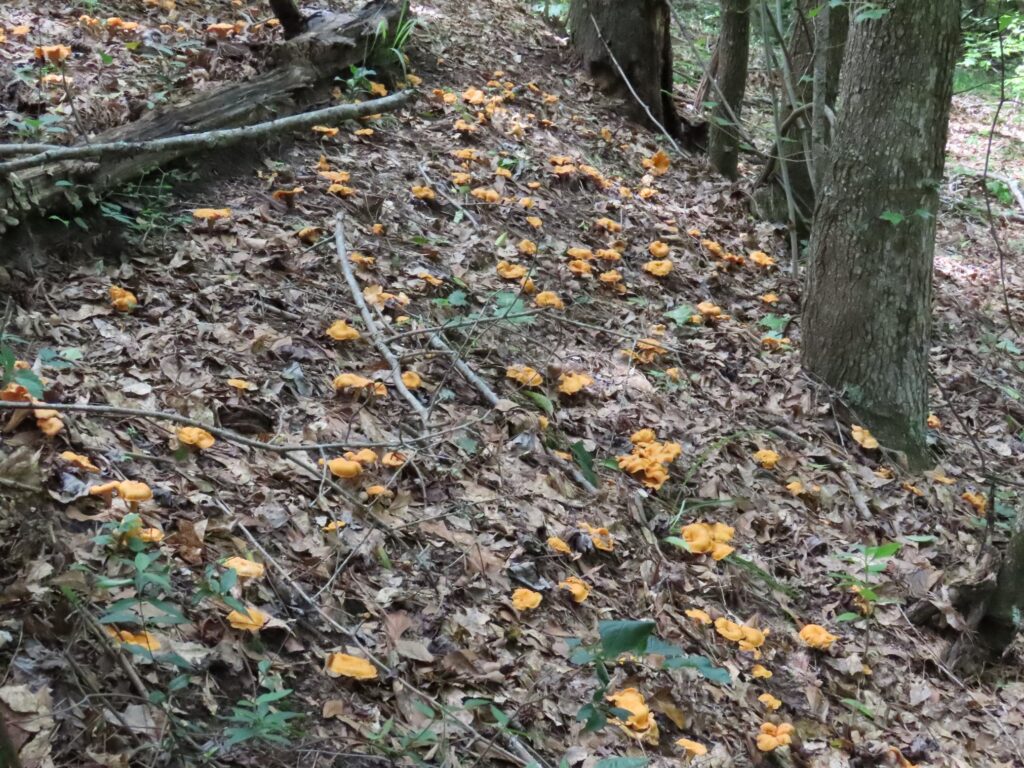
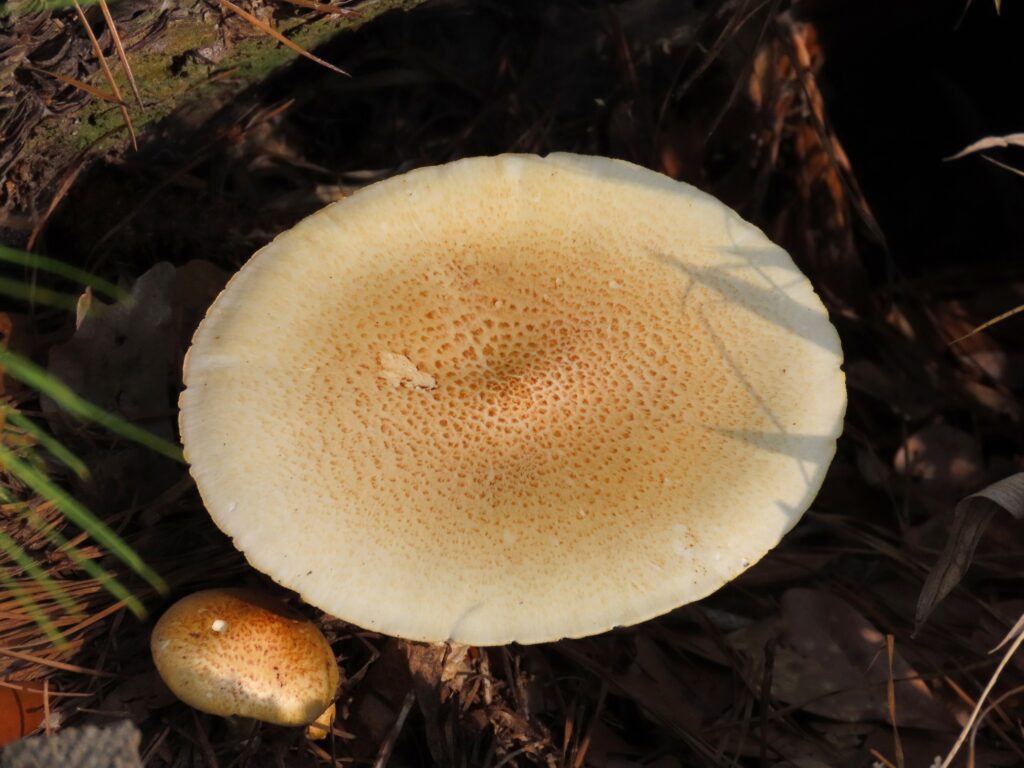
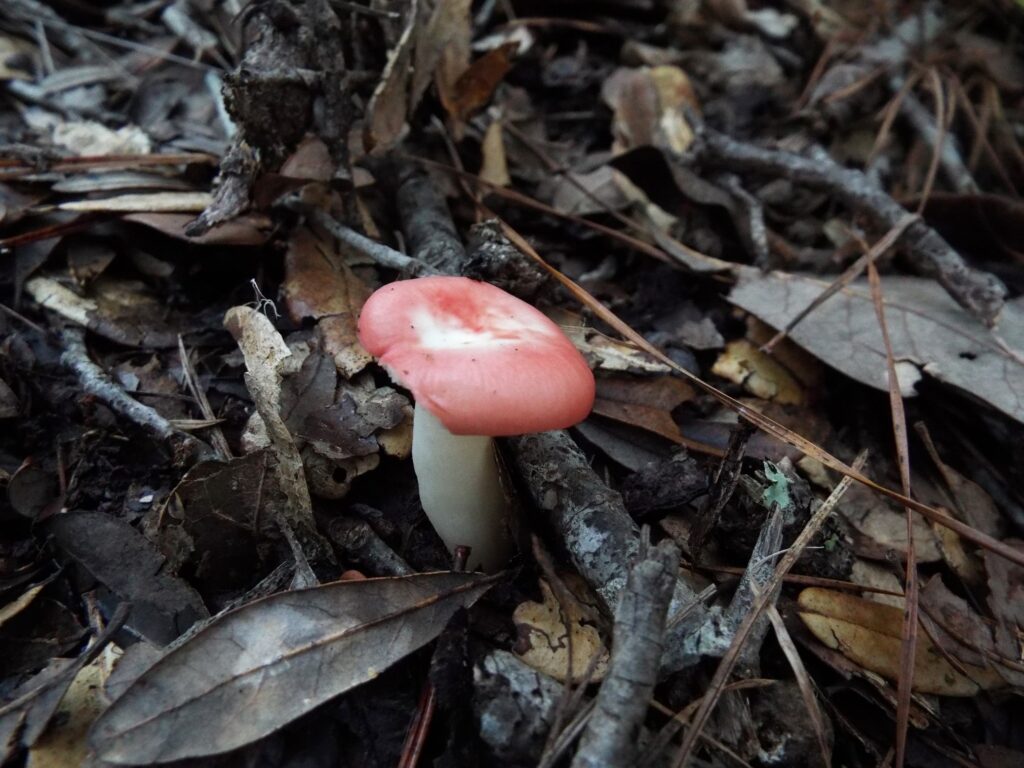
This week for Flora and Fauna Friday we have a very important member of our local ecosystem that we all have seen but only a few recognized: ectomycorrhizal fungi.
Now, mycorrhizal fungi are not a specific clade of fungi. They’re a group of fungi who play a similar role in the ecosystem. That role is a mutualistic relationship with plants, most easily observed in the wild on trees. The plant and the fungus work together and the partnership is a win for both organisms. Mycorrhizal fungi are a critical link in the nutrient cycle and, without them, timber production and forest vigor would be far reduced in many parts of the world. Many of the mushrooms you commonly see, such as Amanitas, Russalas, and Boletes, are mycorrhizal fungi and so are many prized edible mushroom like Chanterelles, Milkcaps, Black Trumpets, and Truffles.
Mycorrhizal fungi live underground. The mycorrhizal relationship happens in the soil at the roots of the plant. The term mycorrhizae literally means “fungus-root” in Latin. Here the hyphae of the fungus and the roots of the plant “hold hands” and form a complex interconnected network of roots. The fungi can then act as an extension of the plant’s root system. This gives the plant a new source of hard to get nutrients and water that the fungus’ hyper-fine hyphae can suss out of the soil and that its specialized enzymes can pull out of detritus. In exchange, the plant feeds the fungus sugars and other carbohydrates that it produced through photosynthesis. Together the two organisms prosper. The plant has better access to nutrition and the fungus gets something to eat other than dirt and sticks.
There are two general groups of mycorrhizal fungi which are defined by how they interact with the plant. They are endomycorrhiza and ectomycorrhiza. The prior can be broken down further into Arbuscular and Ericoid but we’ll save that for another day. The main difference is that endomycorrhizal fungi live inside the cells of the plant’s roots and ectomycorrhizal fungi live outside the plants roots. I’ll mainly be talking about ectomycorrhizal fungi today. However, just know that endomycorrihzal species are far more common and associate with many more plant species. Yet, they’re much harder to observe and are obligate symbionts, meaning they can’t survive for long without a host plant to attach to. Ectomycorrhizal fungi on the other hand are usually not dependent on a host. They can live freely in the soil as a saprotrophic fungi. (Fungi that get their meals by digesting detritus and rotting plant material in the soil.) These ectomycorrhizal fungi generally associate with woody plants, like shrubs and trees, and are also the species that produce the highly visible, and sometimes edible, mushrooms we often see scattered across the forest floor. Their saprotrophic abilities combined with their mycorrhizal relationship allow them to speed up the nutrient cycle in forest ecosystems. Fast tracking nutrients, that would otherwise be locked up in leaf litter, back into the trees. This makes forests more resilient allowing them to better respond to and recover from logging or natural disasters.
We’re happy to report that the National Trust for Historic Preservation has featured the Hutchinson House on the cover of their most recent Winter, 2021 issue of Preservation Magazine.
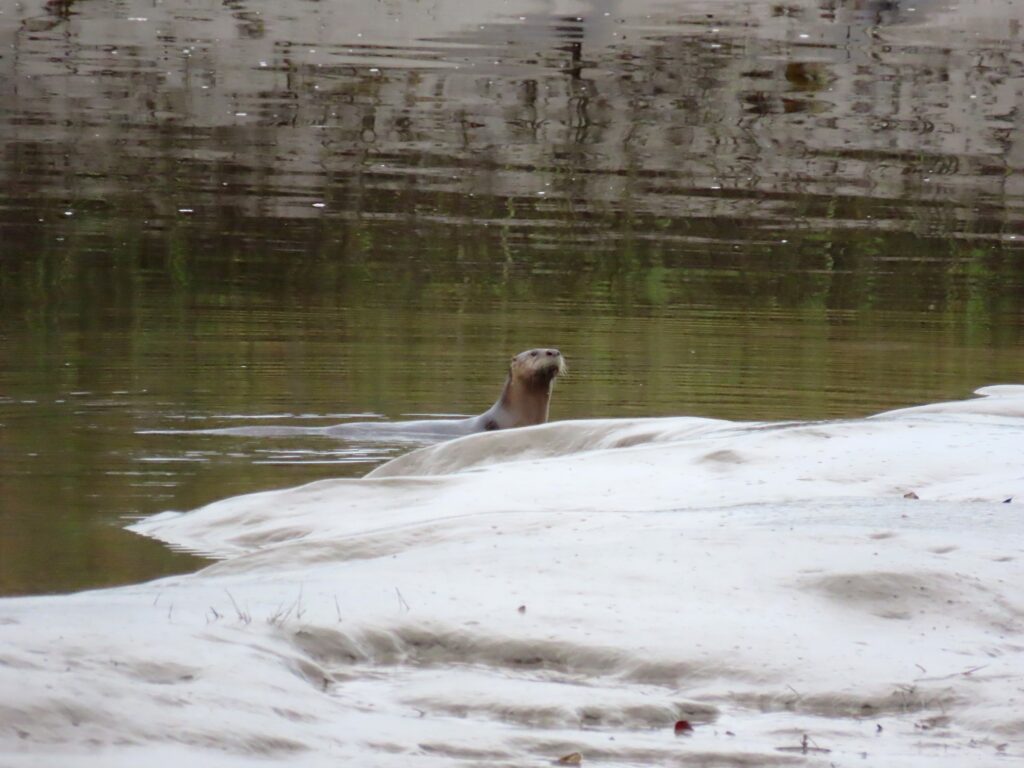
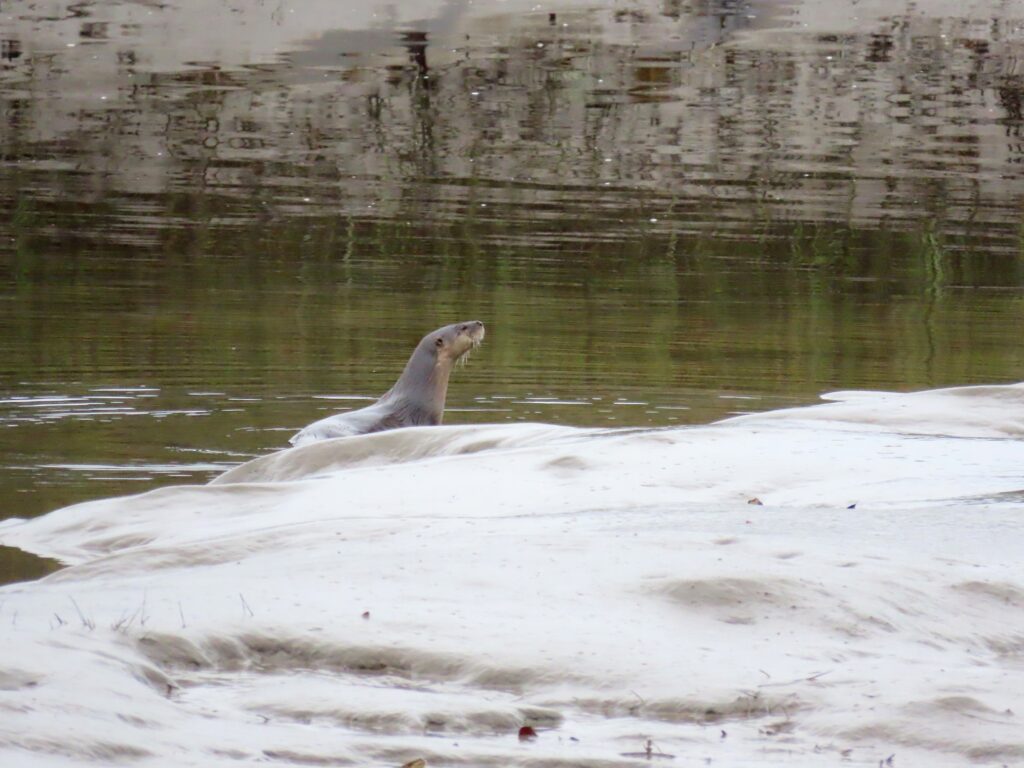
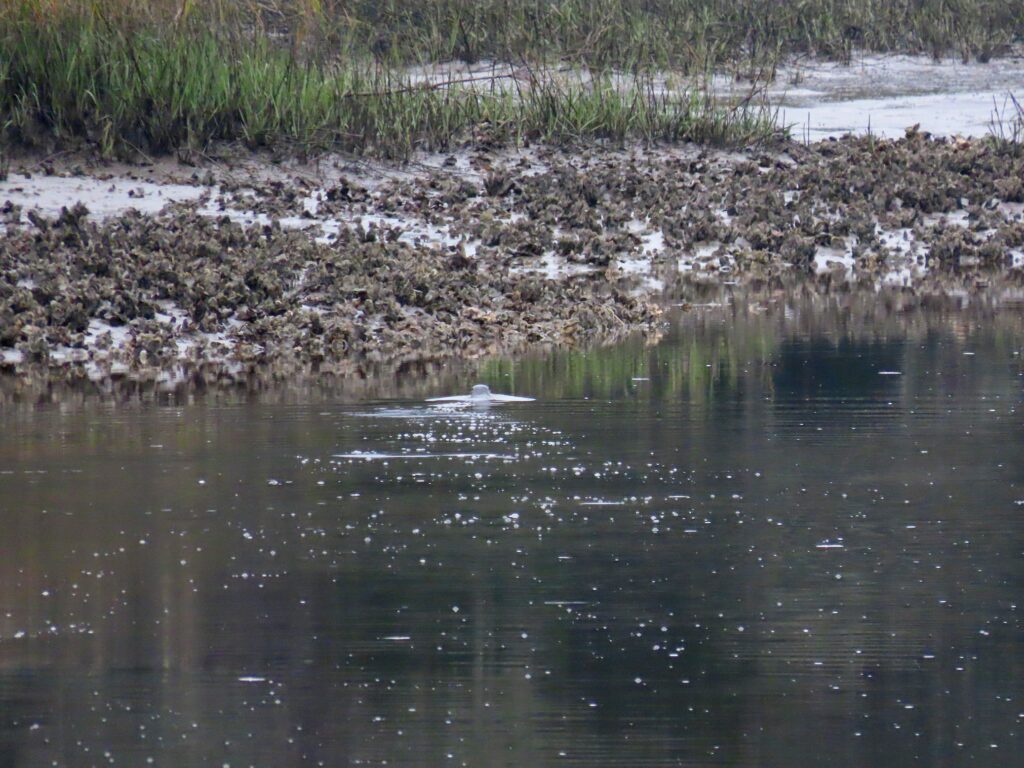
This week for Flora and Fauna Friday is our big water weasel: the North American River Otter (Lontra canadensis).
Weighing in at roughly fifteen pounds and three foot long, River Otters are our biggest member of the weasel family. Their pelt is dense and oily-brown across their long, serpentine body. Their legs short and stocky with wide, webbed toes. Their tail is long and broad, thick with muscle as it tapers to the tip. Their tiny ears, long whiskers, beaded eyes, and round dark nose give them an indisputable teddy bear demeanor and cat-like elegance. River Otters use their broad tails, long bodies, and webbed feet to shuttle through the water and wrestle with fish. Their long whiskers let them feel prey in the dark, muddy waters they hunt. Their diet is entirely carnivorous, with their preference being fish, then crustaceans. They will also eat ducklings, frogs, and rails if encountered. In freshwater, their main predator is the American Alligator.
They’re chiefly nocturnal and cycle through their favorite haunts in our creeks, salt marshes, ponds, and swamps over the course of the night. They show little preference for salt or not on Edisto. River Otters are an intelligent and social aquatic mammal that’s prone to fits of frolicking and curiosity as it stalks our creeks and warily watches us from the water’s surface. They travel in small family groups of a few Otters a piece and can be heard in the dead of night grunting, splashing, slipping, and sliding over mud and berm as they roughhouse, slither, and gallop through the brush. Often, the only signs we ever see of their presence are webbed footprints, muddy tail drags, and a scattering of fish scales across a trail.